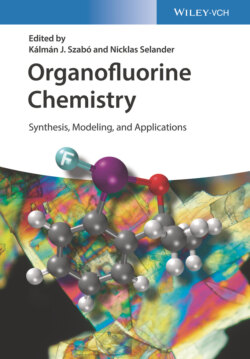Читать книгу Organofluorine Chemistry - Группа авторов - Страница 28
2.2.3.1 Using Copper Salts
ОглавлениеCross‐coupling‐type perfluoroalkylations of pre‐functionalized aromatic compounds can selectively afford target molecules bearing a perfluoroalkyl group at a specific position of the aromatic ring, in contrast to the electrochemical perfluoroalkylations of aromatic compounds mediated by perfluoroalkyl radicals. In 1981, Kondo and coworkers achieved a convenient copper iodide‐mediated trifluoromethylation of aromatic halides with sodium trifluoroacetate, obtaining the desired trifluoromethylarenes from aryl iodide and bromide in up to 88% yield (Scheme 2.17a) [31, 32]. Suzuki independently reported a similar reaction using the combination of sodium trifluoroacetate and copper iodide [33]. Chambers further investigated the scope of the reaction under Kondo's conditions; perfluoroalkylations using sodium pentafluoropropionate and heptafluorobutyrate were found to be viable, and pentafluoroethylation of β‐bromostyrene and 1‐iodopentane, as well as various aryl halides, was demonstrated (Scheme 2.17b) [34]. A nucleophilic intermediate [CF3CuI]− was proposed as the reactive species [35]. Kondo's conditions were also applied by Miller and coworkers [36] and Ammann and coworkers [37], who synthesized trifluoromethylated aromatic compounds for evaluation of their biological activity.
Scheme 2.17 Cu‐mediated decarboxylative coupling of (a) aryl halides with trifluoroacetate; (b) β‐bromostyrene and iodopentane with sodium perfluorocarboxylates (NMP, N‐methylpyrrolidone).
In 2013, Buchwald and coworker greatly enhanced the synthetic and practical utility of the trifluoromethylation method using the combination of trifluoroacetate salt and copper iodide by employing a flow system (Scheme 2.18) [38]. These conditions showed excellent efficiency and substrate scope, and a diverse array of trifluoromethylated arenes and heteroarenes could be obtained in up to 96% yield with only a 16 minutes residence time (tr).
There have been a few attempts to control the reactivity of copper perfluoro carboxylates by using ligands. Vicic and coworkers prepared N‐heterocyclic carbene (NHC)–copper‐trifluoroacetate and ‐chlorodifluoroacetate complexes and examined their reactivity for trifluoromethylation of aryl halides (Scheme 2.19) [39]. (SIiPr)Cu(O2CCF3) greatly enhanced the yield of trifluoromethylation compared to “ligandless” conditions using CuI and CF3CO2Na in aryl halide solvent (neat conditions). In addition, (SIiPr)Cu(O2CCF2Cl) was found to be available as a precursor for trifluoromethylation in the presence of CsF.
Scheme 2.18 Application of a flow system to coupling‐type trifluoromethylation.
Scheme 2.19 N‐heterocyclic carbene‐ligand enhanced trifluoromethylation with copper trifluoroacetate.
Weng and coworkers developed efficient trifluoromethylations with copper‐trifluoroacetate and chlorodifluoroacetate complexes possessing diamine ligands: 1,10‐phenanthroline (phen) and 2,2′‐bipyridyl (bpy) (Scheme 2.20) [40].
The reaction of aryl iodide or heteroaryl bromide with well‐defined [(phen)Cu(O2CCF3)] in the presence of NaF as an additive afforded the desired trifluoromethylated products (Scheme 2.20a) [40a]. Because the “ligandless” conditions previously reported required a higher reaction temperature (160 °C) for the decarboxylation, the ligand was considered to facilitate the reaction. Mechanistic studies indicated that radical intermediates are unlikely to be involved in the reaction – instead a reactive species with nucleophilic character was proposed. In addition, copper‐perfluoro carboxylate complexes [(phen)2Cu](O2CRf) (Rf = C2F5, C3F7, C4F9, C5F11), as well as the combination of [(phen)Cu(O2CCF3)] and Na2CO3, were found to show sufficient reactivity in decarboxylative perfluoroalkylations of E‐β‐bromostyrenes, affording the desired trifluoromethylated styrenes in up to 98% yield in a stereospecific manner [40b]. Weng's group reported trifluoromethylation of (hetero)aryl iodide and bromides with a copper chlorodifluoroacetate complex (Scheme 2.20b) [40c]; in the presence of NaOH and CsF, the reaction of aromatic halides and [(bpy)2Cu](O2CCF2Cl) gave trifluoromethylated products in excellent yield, via difluorocarbene and subsequent formation of CuCF3 species.
Scheme 2.20 Trifluoromethylations using diamine–copper complexes: reaction of (a) copper‐trifluoroacetate, (b) copper‐difluorochloroacetate (DMF, N,N,‐dimethylformamide).
Chen and Liu employed Cu(O2CCF2SO2F)2, which was decomposed in N,N,‐dimethylformamide (DMF) at room temperature to generate CF2 carbene and fluoride, in the trifluoromethylation of aryl iodides and aryl bromide. The reaction required a stoichiometric amount of additional copper metal in order to form a reactive CuICF3 intermediate (Scheme 2.21) [41].
Scheme 2.21 Trifluoromethylation with Cu(O2CCF2SO2F)2.
Scheme 2.22 Cu‐catalyzed trifluoromethylation of aryl iodides. using Ag2O as a promoter.
Scheme 2.23 Nucleophilic addition of trifluoromethyl group to carbonyl compounds.
Although various trifluoromethylations with combinations of copper salts and trifluoroacetate salts had been developed, a stoichiometric amount of copper salts was necessary in almost all cases. To overcome this limitation, Li, Duan, and coworkers developed a copper‐catalyzed trifluoromethylation of aryl iodides with sodium trifluoroacetate using Ag2O as a promoter (Scheme 2.22) [42]. The use of copper catalyst alone gave the trifluoromethylation product in low yield, but the addition of Ag2O dramatically improved the yield. Notably, the use of Ag2O alone did not give any product at all.
Beside the cross‐coupling‐type trifluoromethylations, the combination of trifluoroacetate and copper salts could be used as an efficient nucleophilic reagent for addition reaction to carbonyl compounds, as reported by Chang and Cai (Scheme 2.23) [43]. Not only aldehydes but also ketones, acetyl chloride, and phthalic anhydride were available for this reaction.
